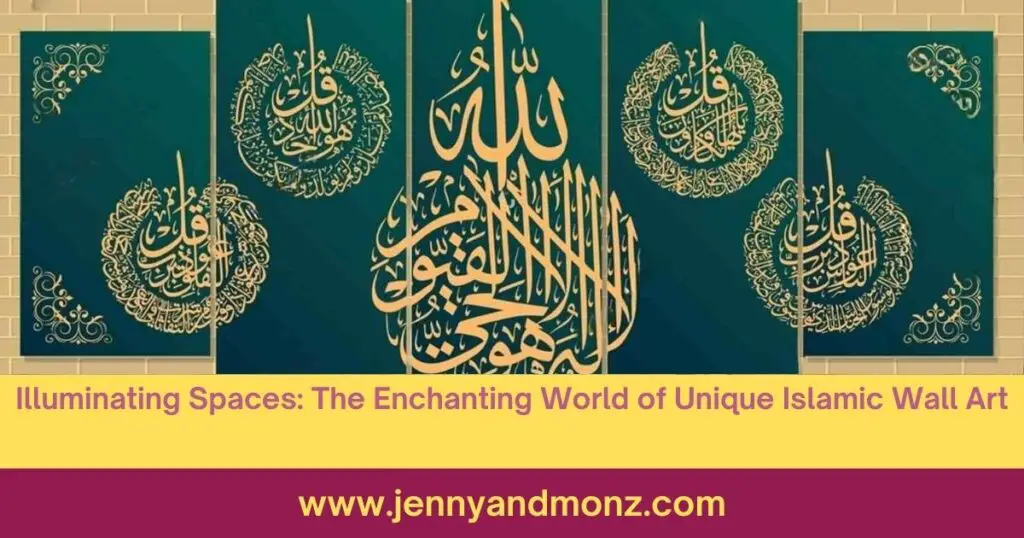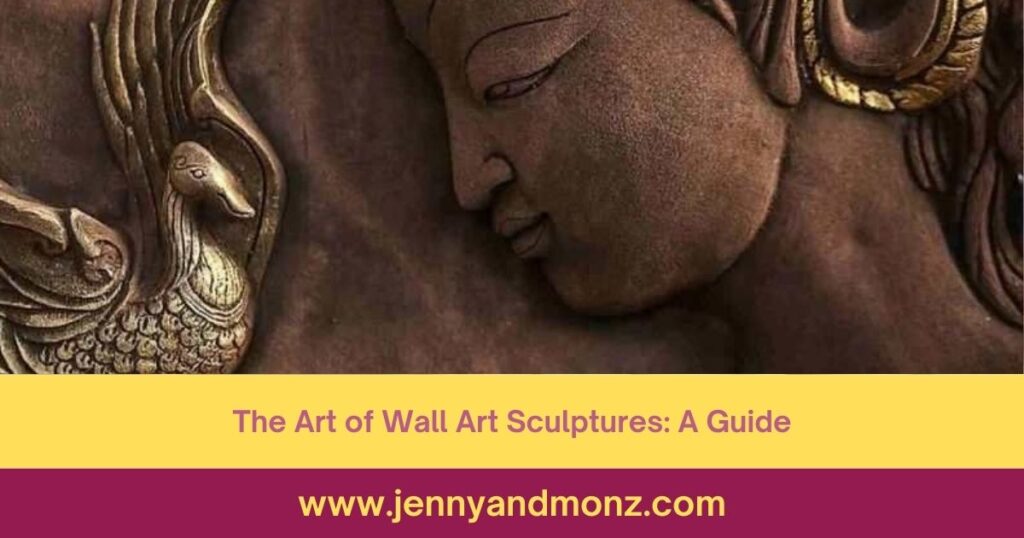Because of its lengthy history, intricate beauty, and significant spiritual significance, Islamic wall art is one distinctive art that stands out in a world full of several other artistic expressions. Islamic wall art’s seductive blend of calligraphy, geometry, and vibrant colors can transform any space into a visual and spiritual retreat. Come on a fascinating journey as we explore the intriguing world of unique Islamic wall painting and uncover its cultural significance and everlasting beauty in its strokes and patterns.
The Art of Calligraphy In ISlamic Wall Art

Islamic wall art is rooted in the alluring beauty of Arabic calligraphy. This ancient art form has long been respected as a means of conveying both the written word and the divine message. Every pen stroke shows the calligrapher’s expertise, accuracy, and dedication to their profession. Islamic calligraphy, however, bridges the gap between the mundane and the sublime, the spiritual and the material, and is much more than just beautiful lettering.
Islamic calligraphy comes in various styles, each with its characteristics and significance. Naskh’s elegant simplicity, Kufic’s angular precision, and Thuluth’s flowing arcserse from the Quran, Hadith, or other religious texts are regularly illustrated using these aesthetic techniques, imbuing the space with a deep spiritual resonance.
The Dance of Geometry

Geometry is another crucial element that lends Islamic wall painting depth and complexity. Islamic painters have always been fascinated by geometry because of its mathematical precision and use it to create stunning patterns that appear to dance and link on the walls. Themes like stars, flowers, and vines are widely used in these designs, frequently drawing inspiration from nature.
Islamic geometric patterns’ alluring repetition and symmetry have great symbolic significance and are visually stunning. They stand for the unity of Islam, which maintains that all things are interconnected and governed by divine rule. The mathematical precision of these patterns serves as a reminder of the universe’s exquisite design and the Creator’s omnipotence.
The Vibrance of the Colors: Unique wall Art-Islamic

People use white and gold to represent purity and spiritual brightness. The choice of colors is not arbitrary; they have cultural and symbolic significance. For instance, blue represents divinity and the heavenly plane, while green represents expansion and paradise. People use white and gold to represent purity and spiritual brightness.
One of the most well-known examples of Islamic color symbolism is the “Blue Mosque” in Istanbul, where exquisite blue tiles create an impression of transcendence and spiritual elevation. Islamic wall art reflects the rich cultural diversity of the Islamic world, with each region contributing its unique colour palette and design elements.
The Sacred Space

Islamic wall art goes beyond basic decoration to transform spaces into spiritual havens. Islamic art promotes a reverent and contemplative atmosphere, Whether in a mosque, a home, or a public edifice. It inspires individuals to access their spirituality and think on the divine message.
The soothing beauty of Islamic wall art can make a big difference in one’s mental and emotional well-being. The intricate patterns and peaceful colors create a tranquil atmosphere that provides relief from the commotion of the outside world. As a result, Islamic wall art is found in places of worship, offices, and private residences, inspiring and calming those who view it.
Contemporary Phrases

Even though it is still ageless and admired, modern artists are reinterpreting classical Islamic wall art to make it relevant to the present. These artists broaden the possibilities for creation by experimenting with new materials, styles, and procedures. Islamic wall art is expanding while retaining its core components, including geometric sculptures printed in three dimensions and digital Islamic calligraphy.
Contemporary Islamic wall art also addresses other topics besides religious ones. It presents a fresh perspective on how tradition and modernity can coexist by examining social issues, identity, and cultural expression. This fusion of the old and new appeals to a wider audience and highlights the Islamic arts’ continuing relevance in the contemporary era.
Message of the Universe Through islamic wall art

Islamic wall art may have roots in the Islamic world, yet it appeals to individuals of various backgrounds. Its enduring beauty and profound spirituality move people from all walks of life. Whether you are a Muslim looking for a connection to your faith or a follower of art and culture, Islamic wall art has something to offer everyone.
In a world where differences frequently act as a dividing line, Islamic wall art reminds us of our shared humanity and the universal yearning for beauty, meaning, and spirituality. It asks us to see beyond the obvious to find the profound meanings concealed in its brushstrokes, patterns, and colors.
Top Masterpieces of Islamic Architecture
Here are the list of top Islamic architecture buildings of the world.
| Sr. No. | Building Name | City | Country | Building Type |
| 1 | The Dome of the Rock | Jerusalem | Palestine | Islamic Monument |
| 2 | The Friday Mosque | Esfahan, | Iran | Mosque |
| 3 | The Alhambra | Granada | Spain | Palace and Fortress |
| 4 | Great Mosque of Samarra | Samarra | Iraq | Mosque |
| 5 | The Citadel of Aleppo | Aleppo | Syria | Citadel |
| 6 | Great Mosque of Córdoba | Cordoba | Spain | Mosque |
| 7 | Suleymaniye Mosque complex | Istanbul | Turkey | Mosque |
| 8 | Taj Mahal | Agra | India | Mausoleum complex |
Islamic art’s Fundamentals
- Encompasses all Muslim art, not just that which is overtly religious.
- Islamic art aims to depict objects’ meanings and essences rather than only their outward appearance.
- People consider crafts and ornamental arts to be fully qualified as art.
- People do not often consider painting and sculpture to be the most noble forms of art.
- A significant art form is calligraphy.
- Islam places a high value on writing.
- An important form of ornamentation for things and structures is writing.
- A significant form of art is books.
- Patterns and geometry are significant.
- People don’t typically appear in religious art.
Conclusion: The Beauty That Bonds
Authentic Islamic wall art demonstrates the enduring power of the arts by crossing boundaries of space, time, and culture. It is a stunning tapestry that uplifts both spaces and souls thanks to the calligraphy, geometry, colors, and spiritual depth that come together in it. Islamic wall art helps us see the universal beauty that unites us all, whether it serves as a modern expression, a cultural asset, or a source of spiritual inspiration.
As we observe, we remind ourselves that we can discover connections in the world of art, which has no boundaries, through intricate patterns and flowing calligraphy. Islamic wall art symbolises unification and urges us to embrace the depth of our shared human past by uniquely fusing tradition and creativity.Let’s continue to let its grace affect us, let its teaching inspire us, and let its embrace unite us.
To access the entirety of the blog’s information in visual form, take some time to watch the video presentation.
Frequently Asked Questions (FAQs)
· What role does calligraphy have in Islamic art?
Islamic calligraphy is the term for the creative process of writing Arabic letters in a beautiful and decorative way. It is essential to Islamic culture for expressing and preserving religious texts, poetry, and other key literature. Arabic calligraphy is renowned for its exquisite aesthetics and exacting precision.
· Which Arabic calligraphy style is regarded as the best in Islamic wall art?
There are many different types of Arabic calligraphy, each with its own distinctive artistic characteristics. Choosing the “finest” style of Arabic calligraphy is a matter of taste and subjectivity. Thuluth, Naskh, Diwani, and Kufic are a few well-known and respected styles. Every fashion boasts unique traits and historical significance.
· Do you suggest any kind of wall decor for a living room?
While choosing wall art, you should consider a living room’s overall style as well as personal preference. Tapestries, wall art, framed images, paintings, posters, and gallery walls of various works of art are popular. Select pieces of art that harmonize with the room’s decor in terms of style and color.
· Why is contemporary Islamic calligraphy unique?
Modern Islamic calligraphy is an example of how calligraphy has been interpreted and expressed in the Islamic art heritage today. While respecting the fundamentals and guidelines of Arabic calligraphy, it entails the investigation of novel artistic techniques, styles, and materials. Modern Islamic calligraphy uses innovative designs, creative compositions, and various media.



